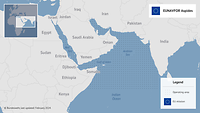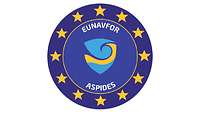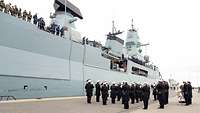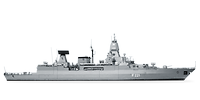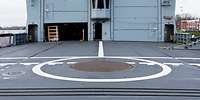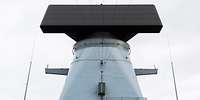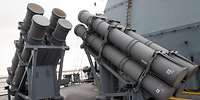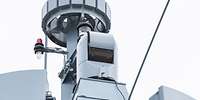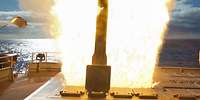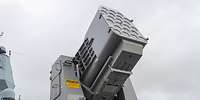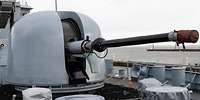Red Sea – EUNAVFOREuropean Union Naval Forces Aspides
The Bundeswehr has been participating in Operation EUNAVFOREuropean Union Naval Forces Aspides since 23 February 2024, with its main focus on the Red Sea. Based on the current decision of the German Bundestag, a maximum total of 700 military personnel can be deployed on the operation.
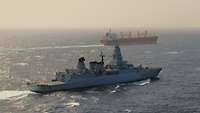
On 19 February 2024, the Council of the European Union – via the Foreign Ministers of its member states – formally decided to launch Operation Aspides. The objective of the defensive maritime security operation is to safeguard freedom of navigation in view of the Red Sea crisis. The operation contributes to maritime security along the most important shipping routes in the operating area.
What is the mission?
The European Union is stepping up its efforts to improve the security of vessels in the Red Sea and to protect the freedom of international shipping. The goal of Operation EUNAVFOREuropean Union Naval Forces Aspides (from Ancient Greek meaning “shields”) is to help protect ships on one of the most important international trade routes against attacks launched by the Houthi militia in Yemen. Germany has been participating in the operation since 23 February 2024, initially with the 124-class frigate Hessen. The frigate, with a crew of around 240, is particularly suitable for protecting ships against multidimensional attacks due to its extensive air defence capabilities.
The EUNAVFOREuropean Union Naval Forces Aspides staff and command personnel runs an operational headquarters with approximately 130 military personnel in Larissa, Greece – commanded by Commodore Vasileios Gryparis. The forward headquarters with approximately 30 personnel, also referred to as the Force Headquarters, is located on the naval force’s flagship within the maritime operating area.
The naval force is commanded by Italy’s Rear Admiral Stefano Costadino. In its first contingent, the naval force for Operation Aspides will comprise four frigates and one reconnaissance plane.
Which ocean areas does the operation cover?
The operating area of EUNAVFOREuropean Union Naval Forces Aspides comprises the Bab el-Mandeb Strait and the Strait of Hormuz as well as the international waters of the Red Sea, the Gulf of Aden, the Arabian Sea, the Gulf of Oman and the Persian Gulf, as well as the airspace above these waters. Operations in territorial waters generally require the approval of the respective coastal states. This does not affect the rights of passage under the United Nations Convention on the Law of the Sea of 1982 or sea rescue operations.
However, the operational protection mission concerning ships is limited by a line south of the port of Muscat in Oman. This also corresponds to the area of the current threat posed by attacks from the Houthi militia.
The extent of the operational area, including the Persian Gulf, will mainly facilitate cooperation and exchange for EUNAVFOREuropean Union Naval Forces Aspides with other international naval operations in the region. This particularly includes the USUnited States-led Operation Prosperity Guardian and the multinational Combined Maritime Forces.
What is the mission’s mandate?
The German Bundestag mandate is based on a decision of the Council of the European Union of 8 February 2024 as well as several resolutions of the United Nations Security Council (UNUnited Nations), in particular Resolution 2722 (2024). The Bundestag, Germany’s parliament, issued its mandate for the participation of the Bundeswehr on 23 February 2024. It is initially valid until 28 February 2025 and allows the deployment of up to 700 personnel.
- UNUnited Nations Security Council Resolution
- EUEuropean Union COUNCIL DECISION (PDF, 493.8 KB)
- German Bundestag Mandate (PDF, 166.6 KB)
As part of the EUEuropean Union’s Operation EUNAVFOREuropean Union Naval Forces Aspides, German armed forces are taking action under the rules of a mutual collective security system according to Article 24 (2) of the German Basic Law. Germany is participating in accordance with applicable international law, including customary international law and the right of self-defence against imminent or ongoing attacks on vessels in the operating area. In addition, the provisions of the United Nations Convention on the Law of the Sea of 1982 must be observed. Furthermore, Operation Aspides is acting in accordance with the UNUnited Nations Security Council Resolution of 10 January 2024, which calls for the Houthi militia to stop their attacks immediately.
What is Germany’s contribution?
The Federal Republic of Germany is sending the frigate Hessen to participate in the operation. The Hessen is expected to remain in the operating area until the end of April. During the second half of 2024, the operation is due to be supported by the frigate Hamburg.
In addition, German personnel will serve as staff in the operational headquarters in Larissa, Greece, and aboard the flagship.
Q&A EUNAVFOREuropean Union Naval Forces Aspides
The mandate of the European Union was established on 8 February 2024 by a decision of the EUEuropean Union Foreign Ministers’ Council. This serves as the basis for the mandate of the German Bundestag, which allows the deployment of German armed forces until 28 February 2025.
The Bundestag mandate sets an upper limit of 700 personnel for the German contingent of Aspides. During personnel and contingent rotations, this upper limit may be temporarily exceeded.
As a so-called air defence frigate, the Hessen was specifically designed for operations such as Aspides. As an F124 Sachsen class frigate, it is equipped with sensors and weapons that can defend entire naval forces against airborne threats.
The most important sensor of the Hessen is the air surveillance radar SMART-L (Signal Multibeam Acquisition Radar for Tracking, L band). It has a range of more than 400 kilometres and can simultaneously detect more than 1,000 targets. A second sensor, the APAR (Active Phased Array Radar) multifunction radar, controls the ship’s own defences with its target tracking mode.
The Hessen can initially use its air defence guided missiles against attacking aircraft or missiles: the long-range SM-2 (Standard Missile 2), the ESSM (Evolved Sea Sparrow Missile) and the RAMRolling Airframe Missile (Rolling Airframe Missile) for close-range targets. A further self-defence capability of the ship are the MASS (Multi Ammunition Softskill System) decoy launchers.
For air defence, but also to engage attacking speedboats and surface drones, the Sachsen class ships are equipped with a 76 mm main gun and a 27 mm light naval gun.
Thanks to its good communication system with radio and satellite connections, the Sachsen class is also capable of leading several other warships simultaneously. The Sea Lynx Mk88A shipboard helicopters are primarily intended for long-range anti-submarine warfare. However, the Sea Lynx can also be used for maritime surveillance and boarding operations. It can therefore be equipped with a heavy 12.7 mm machine gun. Other possible tasks include rescue flights for persons in distress at sea or transport flights for personnel and equipment, for instance between the vessels of a naval force.
The first contingent with the frigate Hessen is currently scheduled until the end of April 2024. All following contingents are planned to last four months, although the duration may vary in individual cases.
There are approximately 240 personnel aboard the frigate Hessen. This includes both the permanent crew and, among others, the naval aviators for the shipboard helicopter, the soldiers of the Navy Sea Battalion, as well as a medical specialist team, a military chaplain and a legal adviser.
From the beginning, besides the German contingent, the mission initially also includes personnel from France and Italy. In addition, Belgium and Greece are planning a temporary participation.
Kontakt für die Presse
-

Bundeswehr/Janin Tietz
Lieutenant Colonel Christian Schneider
Spokesperson for the Bundeswehr’s international crisis management operations, in particular UNIFILUnited Nations Interim Force in Lebanon, EUNAVFOREuropean Union Naval Forces MEDMediterranean Irini, VJTFVery High Readiness Joint Task Force (M), EUNAVFOREuropean Union Naval Forces Aspides, NATONorth Atlantic Treaty Organization support in the Aegean Sea, in Niger as well as for observer, advisory and assistance missions
-

Bundeswehr/Florian Sorge
Lieutenant Commander Philip Nitsche
Sprecher für die Einsätze der Bundeswehr im Internationalen Krisenmanagement insbesondere UNIFILUnited Nations Interim Force in Lebanon, EUNAVFOREuropean Union Naval Forces MEDMediterranean Irini, VJTFVery High Readiness Joint Task Force (M), EUNAVFOREuropean Union Naval Forces Aspides, NATONorth Atlantic Treaty Organization-Unterstützung in der Ägäis, in Niger sowie bei Beobachter-, Berater- und Unterstützungsmissionen


